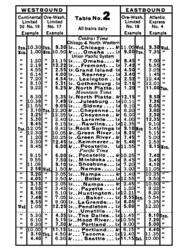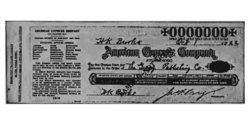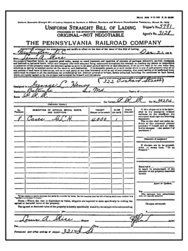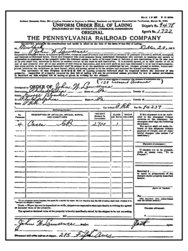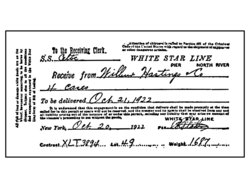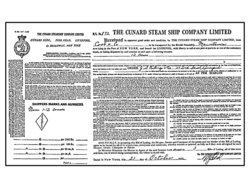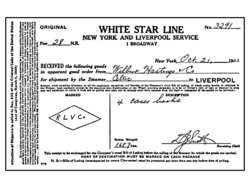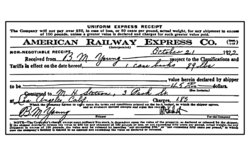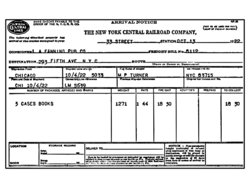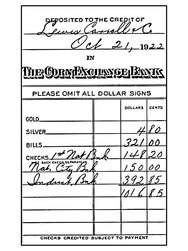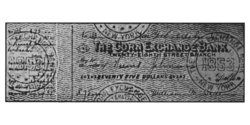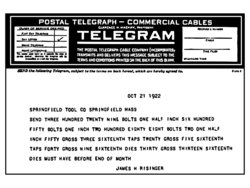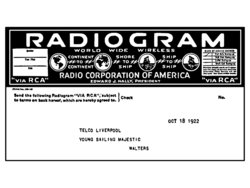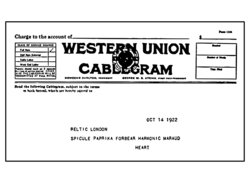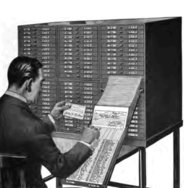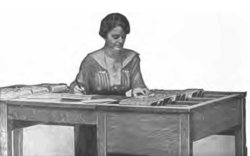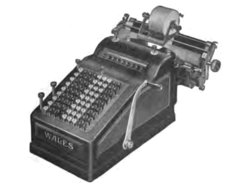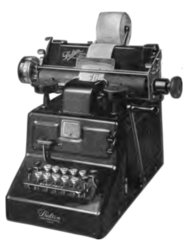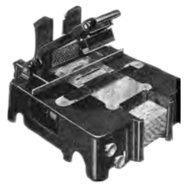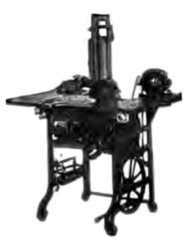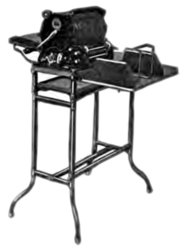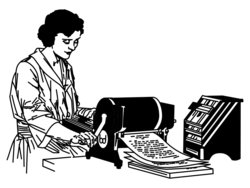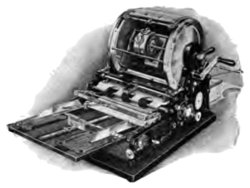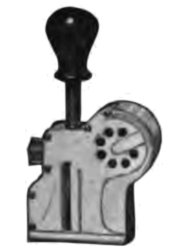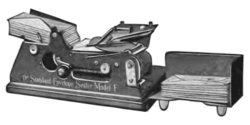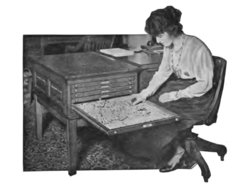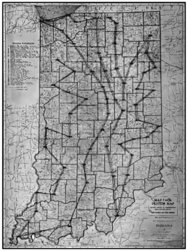Section XIII: Transportation
Transportation applies to individuals and to merchandise. In a large organization the secretary will not come in direct contact with the transportation of merchandise to any extent unless he is acting as secretary to a traffic manager or the head of the shipping department.
So far as transportation is concerned his activities will be confined mostly to securing tickets for his employer, making sleeping car reservations, consulting timetables, arranging itineraries, or routes, directly for his employer or for other executives, or representatives under his supervision.
The secretary, however, should be familiar with the whole general scheme of transportation because it will assist him in taking care of such matters as come directly in his line of duty, and will enable him better to understand correspondence relating to the subject.
Shipping terms will be of obvious value to him. These should be the subject of special study to learn their meaning, and also for the purpose of enabling him to provide rapidly written outlines for them. This information is especially necessary to the secretary who will be called upon to dictate or write letters himself concerning transportation. To understand the important part transportation plays in business and how it functions, the secretary must be familiar with commercial and industrial geography.
Itineraries and Routes - In arranging business itineraries - a duty that often falls to the secretary - it will be necessary to make a thorough study of the situation. Usually the employer will hand the secretary a memorandum giving the names of the places he intends to visit, the time he will start, the approximate time he will spend at each place, and when he expects to return to his office. If there are several lines of transportation from the city which he intends to leave, he will usually express a preference. He will then leave the details of the trip to his secretary. As time is an important element, especially when he is away from his office and loses direct touch with the affairs that normally come to his attention, it will be necessary for the secretary to consult timetables, or the railroad guide, and map out a route which will conform as nearly as possible to the tentative schedule. Since most of the large cities are connected by more than one line of transportation a study of the various train schedules will enable the secretary to select routes that will conform practically to the program. If the cities to be visited are close together, a rapid transit trolley route may oftentimes be selected. In other cases there are automobile stage lines, or even in the case of necessity an automobile may be hired for a special trip. It often happens that the added expense of such an arrangement will be more than offset by the saving in time and in hotel charges. The secretary should make inquiries about special rates to be obtained, as frequently there are summer rates or special round-trip rates between different points where a great saving of railroad fare can be secured.
He will see to it that as much as possible of the traveling is done at night, or after business hours, when there will be no loss of time. Most business men, as a rule, have no objection to traveling on a sleeping car; they have become so used to it that it is a mere incident in the day's work. It is a far less fatiguing time of travel than in the daytime.
After the preliminary itinerary has been prepared it should be submitted to the employer for his approval. When the itinerary has been finally approved, the secretary will make advance reservations of rooms at hotels. The names of hotels may be secured from the hotel guide unless the employer has given instructions as to the hotels at which he wishes to stop. In writing for hotel reservations be sure to specify just what is wanted, and ask specifically for an acknowledgment of your letter. This correspondence should be placed in a folder to be taken by your employer, as it may be the means of settling a misunderstanding. When it is necessary to wire for accommodations the same rule should be followed. The secretary should ascertain what luggage is to be taken and arrange for transportation of trunks from the employer's home to the station of departure. At other places it will be necessary, of course, for the employer to look after this detail himself. Even when the secretary is expected to accompany his employer, all these arrangements should be made in advance, whenever possible, to avoid any unnecessary delay.
The employer should be consulted as to whether he desires to use extra fare trains wherever possible. On such trains there is an additional charge for the luxurious accommodations of the train, or for the time saved by the speed of the train. On many of these, special round-trip or excursion-rate tickets will not be honored. Many business men prefer to travel on a form of transportation ticket called “mileage.” Mileage is sold in ordinary times at a slightly reduced price. At present, however, there is no reduction in the cost of transportation by securing mileage tickets. The only advantage to be obtained from securing this form of transportation is its convenience, since sufficient mileage can be obtained to cover an entire trip and thus tickets need not be purchased at various points. The unused mileage will be redeemed.
Pullman Reservations - After the itinerary is definitely settled, Pullman reservations should be made in advance in order to insure keeping the schedule intact.
Forwarding Mail - Arrangements should be made with the office for the forwarding of all mail requiring the executive's attention. A schedule of the points to be visited, the dates, and the hotels at which he will be stopping should be supplied. It is better to have all mail for a given day put in one envelope containing a return address, with the instructions placed on it either to hold or forward. Memoranda of all mail forwarded should be kept. In the case of very important letters copies should be made and mailed, so that, if the mail is lost, all the original correspondence will still be available. Correspondence of unusual importance should be registered so that a receipt can be obtained for it.
Funds - The employer should be consulted about the funds he will take and bank drafts or travelers' checks provided.
Deferred Matters - The secretary will see that his employer is provided with all necessary correspondence relating to deferred matters which he has in his tickler file, so that these may be disposed of before the journey begins, or taken along to be attended to at the time scheduled. Usually the executive will make some disposition of these matters, so that he will not be burdened with them on the trip. Only such matters as absolutely require attention in transit should be taken. Many business men, without good organizing ability, fill a brief case or suit case with papers and documents which they never use. Oftentimes these papers are needed at the office and thus delays are occasioned in taking care of matters that could be avoided by careful planning. The secretary, by tactful suggestion should help his employer make a selection of matters that will only require his personal attention. In case important matters have been overlooked the information or data necessary may usually be secured by telegraph, provided, of course, that an effective filing system is in use in the office.
Secretarial Problems: Review and Research Questions
-
State the steps the secretary will follow in making up an itinerary.
-
What is meant by an “extra fare train”?
-
What arrangements should be made with regard to the employer's mail?
-
How will deferred matters be handled?
-
How are Pullman reservations made? Hotel?
-
May Pullman or railroad ticket reservations be made by telephone? If so, what are the steps?
Secretarial Problems: Laboratory Assignments
-
Mr. Charles Chapin of our New York office plans to leave New York Tuesday afternoon for a trip to Chicago and Detroit, going to Chicago first. He expects to be in Chicago Wednesday and Thursday, Detroit Friday, returning to New York Saturday. Secure the following data:
-
Train on which he will leave; time of departure and arrival.
-
Hotels at which he will stop in Chicago and Detroit.
-
Time he will leave Chicago to arrive at Detroit the next morning.
-
Time he will leave Detroit.
-
Write the form of letter necessary to secure room and bath at hotels in Chicago and Detroit. Two letters.
-
Dictation.
-
Transcription.
Transportation, part II
Timetables - If the secretary is unacquainted with the method of reading timetables, he should familiarize himself with it. The timetables issued by the various transportation companies contain a remarkably large fund of information, given in the most compact form. Figure XXII shows a specimen of one of these. They give the connections with other railroads, time of departure and arrival of trains, condensed timetables for the longer journeys, the equipment of the train, the time it takes to make the trip by days and hours, Pullman car fares, and maps. The light figures on a timetable indicate the hours between twelve midnight and twelve noon; the dark figures, from twelve noon until twelve midnight.
Baggage - The secretary will naturally familiarize himself with the baggage limitations of weight and value. The baggage that will be checked free is limited to 150 pounds, and the value liability to $100. Transportation companies require a release of value beyond that amount. If the baggage is of greater value, it must be declared and an extra charge will be made for carrying it. Some transportation companies place a limit on the weight and size of a single piece of baggage - 250 pounds in weight and not larger than 72 inches in its greatest measurement. The value limit is $2,500.
Difference in Time - In traveling from the East to the West there is a gain of approximately one hour to each 1,000 miles of distance. In traveling from the West to the East there is a loss of approximately one hour in each 1,000 miles. Reading from east to west, the classification of “times” of the various sections of the country - generally at arbitrarily fixed points - is as follows: Eastern time, Central time, Mountain time, Pacific time. Thus in traveling from New York to the Pacific Coast on the New York Central and Union Pacific Railroads, timepieces are moved backward one hour at the following points: Eastern time at Cleveland, Ohio; Central time at McCook, Nebraska; Mountain time at Ogden, Utah; Pacific time at the coast.
In arranging schedules of travel these factors must be taken into consideration. The time given on timetables is the standard time of the point named. Some confusion exists now on account of the operation of “daylight saving time.” This factor also is to be considered.
Travel Agencies - In many of the large cities travel agencies make it a business to arrange itineraries, taking care of all the details of a journey, such as the purchasing of tickets, Pullman car reservations, hotels, buses or taxis, transfer of baggage, and so on. They may be consulted freely, and frequently offer superior advantages. They are of particular advantage in traveling to foreign countries, as many of the agencies maintain offices in nearly every important city of the world. They offer advantages in the way of handling funds; give definite data about side trips, and various matters that the traveler can utilize to great advantage.
Travel Abroad - Definite information concerning passports, sailings, and all the details of foreign travel may be secured through the travel agencies. This subject is too complicated to discuss here.
Traveler's Check - The traveler's check is a form of insured travel funds to be carried in place of cash. The buyer signs it when he purchases it and signs it again in the presence of the person taking the check. It is thus self-identifying. It is accepted as cash all over the world, and is always cashed at the dollar valuation so that the holder obtains the advantage of the current exchange rate.
Secretarial Problems: Review and Research Questions
-
What information is contained on a railroad time table?
-
What do the light figures on a time table mean? The dark?
-
What is meant by “surtax charges” on Pullman tickets?
-
What is the limit of weight on baggage? Value?
-
What charges are made for baggage?
-
What is meant by “difference of time.” Name the different times indicated on a transcontinental line, such, for example, as the Union Pacific, the Southern Pacific, the New York Central, the Santa Fé, and the difference in time of each, traveling west.
-
What is meant by “connections”? “Differential”?
-
What is the function of a travel agency?
Secretarial Problems: Laboratory Assignments
-
With the aid of a time table of one of the lines mentioned in the foregoing questions, map out a trip from San Francisco to New York, for one of our salesmen, via the Southern Pacific and Northern Pacific routes. In making up the schedule state the name of the train, its time of departure, arrival, the number of days and hours consumed in transit.
-
Make up for the manager's information, a schedule of a trip from your town to the farthest of one of the following cities: New York; Chicago; San Francisco; New Orleans; Seattle; Portland, Maine. Give the same data as indicated in the first exercise.
-
Plan a transcontinental trip from Los Angeles, California, to New York City, with stop-overs at Salt Lake City, Denver, St. Louis, and Chicago. Give the data indicated in the first exercise.
-
Dictation.
-
Transcription.
Section XIV: Transportation of Goods
Shipping activities are among the most important in any business where goods are manufactured or distributed. This classification covers a majority of business organizations. The secretary must be familiar with the technique of shipping if he comes in contact with it at all, and even if he does so only incidentally, his value will be increased by a knowledge of it.
Methods of Shipping - There are three ways of shipping merchandise, by freight, by express, by mail. Each has distinctive advantages, dependent upon circumstances and the nature of the merchandise to be shipped. Two factors enter into the question of any shipment, cost of transportation and speed in delivery. Customers usually specify the method of shipment, as they are better able to judge the necessity for speed. Where no definite instructions are given, the matter must be decided by the shipping or the traffic department. Shipments by freight are slow but less expensive than by express. For shipments weighing one hundred pounds or more, freight or steamship transportation is less expensive than express. For small packages, parcel post is probably the most satisfactory means of transportation. The comparative expense of parcel post and express should be determined in each individual case.
Shipping Terms - The meaning of shipping terms must be understood. Goods are referred to as “shipments,” or “consignments,” although strictly speaking there is a distinction in the terms. The person shipping the goods is known as the “consignor” and the one to whom they are shipped, the “consignee.” The transportation company, of whatever nature, is called a “carrier,” or “common carrier.” The term applies to railroads, steamship lines, canal boat lines, trucking companies, ferries, and the like. A railroad or steamship company is referred to frequently as a “line;” a “route” is the course a shipment takes from one point to another. It is obvious that with so many railroads, steamship lines, etc., some of which only touch certain territories, frequent transfers from one line to another are necessary. For example, a shipment may be moved via the Pennsylvania and the Southern Pacific, or may go part way by railroad and part by water. “Via lake and rail” means that a shipment is routed so as to go part of the way by railroad and part by water transportation on the Great Lakes.
“Traffic” applies to the conveyance or movement of goods; as, “railroad traffic,” “ocean traffic,” “lake traffic,” etc.
A “way bill” is the freight conductor's list and description of the goods carried on his train.
F. O. B. means literally “free on board;” that the goods will be delivered to the transportation company without charge for cartage or loading.
C. I. F. is an abbreviation of “cost, insurance, freight,” and when used means that the shipper pays the cost of these items, or does not, depending upon the statement.
C. O. D. is an abbreviation of “collect on delivery,” and means that the goods are to be paid for on delivery by the transportation company. The payment is made to the agent of the transportation company, who in turn transmits it to the shipper. A charge is made for this service.
“Fgt.” or “frt.” is an abbreviation of “freight.”
A “manifest” is a list of goods to be shipped by ocean transportation. It shows the value of the goods for the benefit of the custom house official.
Shipping Department - The shipping department of any business handles the orders which come to it from the order department, or from the traffic department, depending upon the organization of the business. In large concerns a traffic manager, an expert in “routing” and “rates,” is in charge of the traffic department and it is supposed to be the business of this department to see that shipments are made in the most economical and best way. Shipments are made only on written order from someone in authority. The usual procedure in the average business is for the person who receives orders to have made out a copy of the original order on a blank invoice form, which has as a part of it a shipping label. This form is made in duplicate.
The shipping label is pasted on the outside of the package. Where cases are used in making shipments of more bulky articles, the name and address of the consignee and consignor are stenciled on the box or case. The shipping department packs, checks, routes, and delivers shipments to the transportation company. The shipping department is supposed to check every item of a shipment against the copy of the order it receives. Packages containing fragile articles, such as glass, are marked “glass,” “handle with care” and are packed with much greater care in wooden boxes or cartons made of corrugated paper with excelsior or paper waste surrounding the articles. “Perishable” applies to articles such as flowers, and fruit. All packages should contain the name and address of the consignee, as well as the name of the shipper. For small packages most companies have a form of label with their name and address on it, on which the consignee's name is typewritten.
Shipments of small packages are sometimes made by first-class mail to insure speed in delivery. These should be marked “By first-class mail,” as the post-office department does not always exercise judgment in this respect.
Delivery of Goods to Transportation Companies - The railroad companies and steamship lines do not call for or deliver freight. This is the business of the trucking or local “express” companies. The express companies call for and deliver packages. Parcel-post shipments are delivered at destination but are not called for at the point of shipment. Packages for shipment by parcel post must be delivered to the post office. C. O. D. shipments should be plainly marked C. O. D. Packages which are “prepaid,” that is, the transportation charges paid by the shipper, should be so marked in order to prevent the possibility of collecting the charges twice.
Shipments going to foreign countries are subject to various regulations, too numerous to be taken up in detail. The secretary in an export house should familiarize himself with the various regulations of foreign countries relating to shipments.
Shipments by Freight - Railroad - Railroad freight rates are based on a minimum weight of 100 pounds. The rate on a package weighing less than 100 pounds is the same as if it weighed the full 100 pounds. If it weighed 125 pounds, however, the rate would be one and one-fourth times the rate of 100 pounds. Weights above 100 pounds are figured pro rata on the basis of 100. As railroad transportation companies do not call for or deliver goods, the question of cartage at each end of the line must be taken into consideration in figuring costs of freight shipments. Usually the shipper or consignor gives quotations, or prices, on his goods f. o. b. his city - which means that he agrees to pay the cartage at his end of the line from his store to the depot.
On small shipments by freight the cost of cartage is often greater than the cost of carrying the goods by rail. It is thus often cheaper to ship by express than by freight, with the added advantage of speed which the express shipment gives.
Secretarial Problems: Review and Research Questions
-
What are the principal types of transportation for goods?
-
What is the function of a “traffic department”?
-
What is meant by “routing”?
-
What is the usual form of handling a shipment from the receiving terminal?
-
What is meant by “C. O. D. shipments”?
-
Upon what is the freight rate based?
-
Who pays the charge for cartage - the railroad company, the shipper, or 'the consignee?
Secretarial Problems: Laboratory Assignments
-
Find out the cost of the following for the use of the manager:
-
The trucking charge on machinery, or farm implements, from our place of business (your city) to the railroad depot. If classification or type of machinery influences the situation find out what the cost is for different types in terms of 100 pounds. Also, whether or not the machinery will be handled by automobile truck or horse trucks.
-
The name of the railroad by which shipments may be made. If more than one, name all.
-
The rate on furniture in knocked-down form from your town to Chicago.
-
Dictation.
-
Transcription.
Transportation of Goods, part II
Classes of Freight - Freight charges are also based on the “kind” or “class” of goods, as well as on the distance transported. A higher rate is necessary on bulky materials than on heavier and more compact articles that require less space. The weight capacity of a freight car ranges from 36,000 pounds. In order to carry freight economically these cars must be loaded to capacity. Furniture, glass, and commodities of that class are naturally more expensive to transport, owing to their liability to breakage and the greater space they require in a freight car. It is obvious that a freight car could not be loaded to capacity with furniture, owing to its bulk compared to its weight.
The classifications generally used in freight shipments, are “first”, “second”, “third”, “fourth” and “special”. The first-class includes certain kinds of furniture and bulky goods. In extra bulky goods the charges may be even higher than first-class; “one and one-half times first-class,” for example, means that the rate is one and one-half times that of first-class.
Bills of Lading - When goods are delivered to a transportation company for shipment, a receipt in the form of a contract for the carrying of the goods known as a “bill of lading” is issued. The bill of lading specifies the goods to be shipped, the name and address of the consignee, the contents of the shipment, and other data which will be clear to you upon referring to Figures XXIV.a and XXIV.b. It is signed by both the shipper and the agent of the transportation company.
Bills of lading are of two kinds, “straight bill of lading,” and “order bill of lading.” An order bill of lading is negotiable; that is, it may be transferred by indorsement. A straight bill of lading is not negotiable, may not be transferred by indorsement or otherwise. A straight bill of lading is used if there is no intention on the part of the shipper to transfer the ownership of the goods to anyone but the consignee. With a straight bill of lading the goods will be released by the transportation company to the consignee named in it, only on surrender of the bill of lading.
An order bill of lading has two purposes: It may be used when it is the intention of the consignor to transfer the ownership of the goods while in transit; or it may be used when it is the intention to ship the goods in the name of the consignor, the title to them resting in him until he makes some disposition of it. For example, the shipper may wish to collect for the bill of goods at the time they are delivered. He has the bill of lading made out to his order. He then attaches to the indorsed bill of lading a commercial draft on the purchaser for the amount and places it with a bank for collection. The bank sends the bill of lading with the draft to its correspondent in the city where the purchaser is located. Upon payment of the amount, the bill of lading, properly indorsed, is turned over to the purchaser. He then presents it at the freight house and receives the goods. The object of a draft bill of lading is to insure the payment of the amount due on the goods before they are turned over to the purchaser. This form of collection is used in case a house is not familiar with the credit standing of a purchaser, or by request.
In the case of a large shipment running into thousands of dollars, a purchaser may require the use of his cash while the goods are in transit. In the shipment of grain, cotton, and many other commodities of commerce, if the owner wishes to dispose of, or obtain money on, the goods called for in the bill of lading while the goods are in transit, he may do so by indorsing the bill of lading to the person or to a bank. The standard form of bill of lading approved by the Interstate Commerce Commission is shown in the Figure XXIV. Many firms provide their own bills of lading and shipping receipts - conforming to the requirements of the regular bills of lading furnished by the railroad companies - in order to save time in filling them out at the freight depot.
Bills of lading are issued in triplicate. The first sheet is known as the “original bill of lading;” the second, as the “shipping order,” and the third, as a “shipping receipt,” or “memorandum.” They are all signed by the shipper and the agent of the transportation company. The original is sent to the consignee, who must present it before the goods will be delivered to him; the shipping receipt is retained by the agent of the carrier, and the “memorandum” is retained by the shipper as a memorandum of the shipment. The three forms are identical in wording, with the exception of the heading, which is slightly changed to make it conform to the purpose for which it is intended.
In some places a bill of lading cannot be obtained at the place where the goods are delivered for shipment; in such a case, or when the consignment is in several parts and is sent to the depot at different times, as, for example, a number of truck loads, a simple shipping receipt is issued to the consignor at the freight house as each load is delivered. When all the cases to be included in the shipment have been delivered to the transportation company, the shipping receipts are presented to the proper official and a bill of lading of the kind wanted is issued.
Payment of Charges - The shipper may pay the freight charges in advance, or have them collected at the receiving end; this is optional in certain classes of goods. When he pays the charges a receipt is issued to him in the form of an “expense bill.” Even in the case where the goods are sold “f. o. b. destination” some firms prefer to have the purchaser pay the freight charges and to deduct the amount from the invoice.
When freight is received by a carrier from a distant point, notification is sent to the consignee in the form of an “arrival notice.” See Figure XXV. Two days are usually allowed the consignee to remove the goods from the freight house or cars, and if the goods are not removed within the designated time, a storage charge, known as “demurrage,” is made by the transportation company. This, of course, must be paid by the consignee.
A special rate may be obtained on certain classes of goods by releasing the transportation company from loss beyond a certain amount per hundred pounds.
Shipment by Water - The method of making shipments by rail applies also to steamship shipments. The form of bill of lading is somewhat different in wording, but its effect is the same. See Figure XXVI.
The shipping receipt issued by steamship lines is sometimes called a “wharf receipt” instead of a shipping receipt. When the shipment of goods to the wharf is in several loads or packages, a wharf receipt is taken for each and when the complete shipment has been delivered, the wharf receipts are exchanged for a bill of lading, as in the case of rail transportation. Shipments going to foreign countries are accompanied by a list of the articles, with their valuation stated. This is called a “manifest.” Some steamship lines require that all goods must be cleared in the custom house before noon on the day of sailing.
The steamship companies allow more time for removing freight than railroads and state on their shipping receipts: “All goods not removed from the wharf within five days after entry of ship will be sent to store at consignee's risk and expense.”
Shipment by Express - Express shipments are usually confined to small packages, or to shipments that require quick delivery. The express companies in all the larger cities make a practice of calling for goods to be shipped and delivering them to the consignee at his place of business. This service is included in the transportation charge. The question of cartage does not enter into the transaction. Express shipments are subject to classification, depending upon the character of the goods, their bulk, and valuation. Express companies issue a receipt for goods known as an express receipt, which, as with bills of lading, is in the form of a contract. See Figure XXVIII.
In places where express companies do not deliver packages, or where for any reason they cannot be delivered, a “notice of arrival” is sent. At the time of delivery of goods the consignee is required to sign a receipt of delivery. When goods are sent C. O. D. by express, the company makes a charge for collecting and returning the money to the shipper.
Secretarial Problems: Review and Research Questions
-
What is meant by “classification of freight”?
-
Why is freight classified?
-
What is a “bill of lading”? Name the different kinds.
-
Which kind of bill of lading is negotiable?
-
What is the object of an “order bill of lading”?
-
How is a commercial draft handled in a draft bill of lading shipment?
-
What is an “expense bill”? “Arrival notice”?
-
What is meant by “demurrage”?
-
How do demurrage charges differ in railroad and water shipments ?
Secretarial Problems: Laboratory Assignments
-
We have received an order from the Bothwell Stationery Company, Springfield, Illinois, for 1500 stenographic notebooks. They request that we ship the goods with draft for the amount attached to the bill of lading. Make out the invoice for the notebooks, at the rate of $62.50 a thousand, the order bill of lading and the commercial draft to be attached. The shipment is in three cases, weighing 249, 253 and 248 pounds respectively. The rate is 98¢ a hundred pounds.
-
We are shipping today to William R. Rufus of Stamford, Connecticut, two cases of mimeograph paper weighing 220 and 210 pounds respectively. Make the invoice at 18¢ a pound and the straight bill of lading.
-
Make out invoice and express receipt for 50 pounds of mimeograph paper shipped by express, charges collect, to Henry L. Camber, Cleveland, Ohio.
-
Dictation.
-
Transcription.
Section XV: The Secretary's Contact with the Bank
The secretary will be expected to attend to certain business at the bank for his employer. He should therefore understand the functions of routine banking so far as his relations with it are concerned. The better he understands banks and financial matters, the more useful he will be to his employer. This is axiomatic with all the activities or phases of business that touch the secretary's work.
Making Deposits - One duty the secretary will be expected to perform in the ordinary office is making deposits of funds either for the business or for the employer's personal account. These funds may be in the form of cash, checks, drafts, cashiers' checks, and notes. To make a deposit at a bank it is necessary to make out a deposit slip (see Figure XXX.) The secretary should supply himself with a quantity of these to be used as the occasion arises. They may be obtained from the bank with which one does business.
A deposit slip is simply a blank form with a place for the name of the depositor, the date, and the kinds and amounts of money or checks to be deposited. Liberty Loan interest coupons or other interest coupons clipped from bonds may very often form a part of your deposit. List these the same as checks or drafts.
The dollar sign should not be used, as the blank is ruled off properly for inserting dollars under dollars and cents under cents. The deposit should be totaled. When you have counted the money, listed the checks and made the footings, take the deposit with the slip and your bank book to the proper receiving teller at the bank. He will check over the deposit and enter it if correct in the bank book, or call your attention to any deficiencies. You should always note the amount in the deposit book to see that it agrees with the footing on your deposit slip. Call the attention of the receiving teller to any differences before you leave the window. In a large bank where a great many receiving tellers are employed to take care of the business, their cages will be labeled “Receiving Teller A-F,” “Receiving Teller G-K,” etc., according to the alphabetic method used in filing systems. By consulting these letters it is easy to determine which is the correct window for you to approach.
Another duty that you will probably be called upon to perform on the instructions of your employer is to draw checks. Drawing a check means to write it out, filling in the blank spaces with the required data. He will either dictate or give you names and amounts of checks to be drawn, or turn over to you bills, invoices, etc., requiring payment.
The Check Book - Checks come in book form. Each check has a “stub” attached, providing a place for the number of the check, the amount, the date, to whom payable, the purpose for which the check is drawn, the balance brought forward - that is, the amount that was still on deposit after the last check was drawn, including subsequent deposits - blank spaces for the amounts deposited that date, the total of the amount brought forward, the amount of the check again, and the amount carried forward, which is the total amount left in the bank after the check under consideration will have been paid. At the time of drawing a check the stub should be filled out in full. See Figure XXXI.
When a check is drawn it should be charged against the bank just the same as if the money had actually been received from the bank. It is important that all the items on the stub are kept up to date and are accurate. The stub should show what your “balance” at the bank is at any given time. Many individuals - some of them good business men - are exceedingly careless about keeping the stub properly filled out and are in a constant state of anxiety as to the condition of their bank account. By keeping the stub always up to date you can avoid drawing checks for a greater amount than you have on deposit. Banks are not legally authorized to pay checks for amounts exceeding the deposit. Checks drawn for a larger amount than is on deposit will be dishonored and a protest charge made against the drawer. This is rarely done with well-known customers of a bank, as the bank will usually get in touch with the depositor by telephone and inform him of the situation, so that funds may be deposited to take care of a check. But it is not good business practice to make this necessary. Occasionally a bank will honor a check which is not covered by sufficient funds, due to a clerical error in the bank. In such cases the depositor will be notified immediately that his account is overdrawn and will be requested to make a deposit to cover the amount. Overdrafts usually are the result either of a failure to keep the check stubs up to date, or of taking the balance in the pass book at a given date without considering some check which might not have been presented for payment in the current month.
In some banks the depositor is required to keep a minimum amount on deposit at all times, as, for example, $300 or $500. If the average daily balance is below the required balance, a banking charge will be made for handling his checks. The theory of this procedure is that by maintaining a certain balance there is not so great an opportunity for overdrafts; and it also covers the actual bookkeeping charges for handling the business, that is to say, a maintained balance of $300 will be sufficient to enable the bank to meet the charges of bookkeeping from the earned interest on the deposit.
Promptness in Depositing Checks - Checks received from other business houses to be deposited should be deposited as soon as possible after receipt. The reason for this is that the check may be good at the time issued, but not good a day or so afterward. Also a check of a deceased person will not be honored at a bank if the bank has received notice of his decease before the check is presented for payment. In such cases the payment of the check will be held up pending the settlement of the estate of the deceased.
The check book and bank book should be kept under lock and key. Canceled checks should be filed. As the practice of different offices varies in this respect, the only thing the secretary can do is to learn what the practice in the office is and adhere to that. Where checks are filed, there is a special file provided for this purpose.
The procedure in the drawing of checks is discussed fully under “Forms of Remittances” and the secretary should acquaint himself with the information therein.
Secretarial Problems: Review and Research Questions
-
What business for his employer will the secretary be likely to transact with the bank?
-
Explain the method of making a deposit.
-
Give the principal points to be observed in drawing checks.
-
What is meant by a “stub”?
-
What is meant by “overdrafts”?
-
What is meant by “dishonoring”?
-
If in your employer's absence a notice is received from the bank in which he makes deposits that his account is overdrawn, how would you meet the situation?
-
How are checks drawn to prevent raising?
-
If you received a check made payable to the order of your employer during his absence and wished to deposit it, what steps would you take?
Secretarial Problems: Laboratory Assignments
-
We shall need the following checks to be used in paying bills which are due today. Make out the proper checks. The blank forms will be found in the Exercise Book.
-
A check for $267.82 payable to Claflin and McLaughlin. Check No. 621.
-
A check for $1377.21 payable to the Westinghouse Electric Company. Check No. 622.
-
A check for $27.41 payable to Cyrus M. Brady, agent. Check 623.
-
A check for $1022.80 payable to Williamson, Wallace and Swinton. Check 624.
-
A check payable to Dr. A. E. Aitkins for $75.00. Check 625.
-
Check payable to ourselves for the purpose of the pay roll; amount $2761. Check No. 626. Attach a memorandum indicating the number of each kind of bills needed; the different amounts in silver.
-
Dictation.
-
Transcription.
The Secretary's Contact with the Bank, part II
Bank Pass Book - Each depositor is furnished with a bank pass book. On the outside of the book is printed the name of the bank, its address, and underneath “In account with,” followed by the name of the depositor. In the front of the book the following note, or one of similar wording, is generally printed:
“This account is accepted and continued by the ............ Bank on condition that checks against it should be drawn only upon the branch with which the account is kept, and all checks credited as a deposit to this account drawn on other offices of the ............ Bank or other banks are received only subject to actual payment by the said other offices or banks.”
The foregoing naturally covers the statement of a branch bank. All amounts deposited at the bank and the date are recorded in this book on the date received. The bank book is signed by the initial of the receiving teller opposite the entry. When deposits are made, the bank book should be handed in with the deposit slip and the funds to be deposited, to the receiving teller. Once a month the bank book should be turned in to the bank for “balancing.” When the book is returned to the depositor it will be accompanied by all checks properly canceled paid by the bank up to that time. The amounts of the various checks will be listed on a slip, rubber stamped “Vouchers Returned by the ............ Bank to ............ (his name) with balance of ............ (date).” This slip is usually made out on a listing machine and may be accepted as correct as to addition, but it should be inspected carefully and checked with all the vouchers for the various amounts represented by the canceled checks. In addition to this, the checks should be checked against the stubs. Before checking against the stubs, check the vouchers (canceled checks) with the list of amounts furnished by the bank. If you find this correct, proceed to compare the checks with the stubs, arranging them first in the order of the check numbers. The balance as shown by the bank should correspond with the balance in your stubs up to and including the last check canceled. If you discover any difference, it will be due probably to the fact that one or more checks have not been presented for payment. By checking the canceled vouchers against your stubs, you can ascertain which these are. The total of the outstanding checks, added to the balance shown by the bank should correspond. Should you discover that this is not the case, each check should be carefully gone over again to ascertain if the amounts on the checks in each instance correspond with the amounts shown on the stubs. You should also compare entries of deposits in your stubs with those in the bank book.
If differences still exist, it will be necessary to go over all additions and subtractions in your stubs. In case you cannot discover any mistakes in your entries, the checks, the stubs, or your arithmetic, it will be necessary to take the matter up with the bank for adjustment. The banks are unusually accurate and it is not often that you can trace errors to them. The employees of a bank, however, are human, and while everything is done to make their work mathematically correct, errors occasionally creep in.
It is now the practice of many banks to send to the depositor on the first of each month a statement of his account, which shows the date and amount of checks paid, deposits, and the balance. This is accompanied by the canceled checks. This method is more efficient, because it saves the depositor the trouble of taking his pass book to the bank and waiting for it to be balanced.
Duplicate Deposit Slip - It is sometimes necessary to make a deposit without having your bank pass book. In such cases make out a duplicate deposit slip, which will be initialed by the receiving teller. This should be presented with your next deposit and the amount entered in the pass book by the receiving teller. Deposits made with duplicate deposit slips are usually entered by the bank as a matter of routine when the pass book is turned in for balancing.
Other Secretarial Banking Duties - The secretary should make a thorough study of all the functions of a bank, the rules and regulations concerning its operation, and the laws applicable to it. These are matters too extended to be treated in a work of this kind, but to the young men or women expecting to rise in the business world, such knowledge is indispensable. The secretary should not hesitate to seek the advice of his banker, or the banker of his employer, on any matters about which he is ignorant. The officers of banks, contrary to the usual conception of the matter, are always ready to give assistance to the seeker for information concerning their operations. Bronze doors and grill work in a bank are not to be considered as visible evidences of inhospitality; they are simply concrete marks of stability.
The secretary may be called upon to go to the bank to bring back various securities, such as bonds, stocks, and other collateral, which may be held to secure a loan. The utmost care should be used in handling such matters to see that all securities delivered to him by the bank correspondent to those either mentioned specifically by the employer or indicated on the note.
It may be necessary in some instances for the secretary to have access to the employer's safety deposit vault for the purpose of filing papers or perhaps securities for safe keeping, but this will depend largely upon the amount of confidence the employer has in the secretary, both as to his ability to handle such matters and as to his reliability and trustworthiness. Of course it is hardly necessary to caution the secretary to be absolutely accurate in his handling of such matters and to keep them in the strictest confidence.
Stopping Payment on Checks - One advantage of checks over money lies in the fact that a lost or stolen check may be made valueless by stopping payment at the bank on which the check is drawn. The maker of the check is supposed to notify the bank, but often the payee or the person to whom the check is made payable gives the warning to the bank.
The stop-payment order must be in writing, and it must reach the bank before the check is presented for payment. An oral stop order is not binding, neither is a telephone request, while a telegraphic stop order would be legally binding on the bank. In filing a stop-payment order the date of the check, the number, the amount for which the check was made out, and the name of the payee must be given.
Commercial and Non-Commercial Banks - There are two kinds of banks; the commercial and the non-commercial. The commercial banks include national and state banks, the banking departments of trust companies, and private banks. National banks operate under a national charter, state banks under a state charter, while private banks are unincorporated. In some states private banks are subjected to inspection by state bank examiners. Commercial banks deal especially in the settlement of business transactions as they receive deposits of cash against which checks may be drawn by a depositor. These banks are often spoken of as banks of discount and deposit. They lend money on short term notes, discount negotiable instruments such as promissory notes and commercial drafts, make collections, and carry on any commercial transactions within the powers granted by their charter.
Savings Banks - Savings banks are non-commercial banks that take small amounts of savings on deposit. These banks afford a safe and moderately profitable means of investing small amounts of savings. They encourage persons of moderate incomes to form habits of thrift by giving a return on savings in the form of interest. Savings banks invest their money on deposit in a prescribed manner and only in safe securities.
Secretarial Problems: Review and Research Questions
-
Describe a bank book and its purpose.
-
What is meant by “voucher”?
-
How may a deposit be made if the depositor does not have his bank book with him?
-
Why should deposits of checks be made as soon as possible?
-
What is done with canceled checks?
Secretarial Problems: Laboratory Assignments
-
We have on hand the following items for deposit in the Second National Bank, your city; make out the proper deposit slip; add up the totals:
| | Gold | 60.00 |
| | Silver | 194.25 |
| | Bills | 398 .00 |
| |
| Checks No. | Name of Bank | Amount |
| 2641 | Western National Bank, Denver | 1472.00 |
| 122 | Columbia Trust Company, New York | 1070.18 |
| 1641 | Irving National Bank, New York | 567.00 |
| 38 | Mechanics Bank, Pittsburgh | 21.00 |
| 4762 | Illinois Trust Company, Chicago | 1928.00 |
-
Make out deposit slip in our name for the following items:
| | Gold | 120.00 |
| | Silver | 98.00 |
| | Bills | 1040.00 |
| |
| Checks No. | Name of Bank | Amount |
| 1628 | Continental and Commercial National Bank, Chicago | 1379.00 |
| 500 | L. L. Coupons | 140.00 |
-
Dictation.
-
Transcription.
The Secretary's Contact with the Bank, part III
Difference Between a Commercial and a Savings Bank - One difference between a commercial and a savings bank is the understanding between the depositors and the bank. A commercial bank will pay the amount of the checks of a depositor, if properly signed by him for the amount for which the check is made out, to the payee or the person named in the check on or after the date it bears, provided the depositor has sufficient funds on deposit in the bank. Savings banks will return any money on deposit either to the depositor or upon his written order and on the presentation of the pass book. They do not encourage demand withdrawals.
In commercial banks the pass book is merely a memorandum of the receipt of deposits, and usually contains no record of the withdrawals of cash or added items of interest. The depositor in a savings bank can make no withdrawals of his money on deposit without producing his pass book in which the amount of the withdrawals is entered by the bank clerk. The pass book of any bank is a receipt for the money deposited and is an acknowledgment by the bank of having received the amount stated on the deposit slip.
Extreme care should always be used in making out a deposit slip in a commercial bank, as it is filed by the bank clerk and is the only legal evidence of the amount of the deposit, should an error be made in entering the amount of the deposit in the pass book. In order to have evidence of the original transaction, banks require customers to make out their own deposit slips.
Federal Reserve Banks - In 1863 Congress passed the National Bank Act providing for Federal supervision of commercial banks, thus securing uniformity in the operation of commercial banks throughout the United States. In 1913 the Federal Reserve Act was passed dividing the entire country into twelve Federal Reserve Districts, a Federal reserve bank being located in each district.
National and Federal Reserve banks may issue money. A national bank note is the promise of a national bank to pay the holder the amount named on the note. The notes issued by each national bank are secured by a deposit of United States bonds with the Treasurer of the United States by the bank issuing the notes.
The Federal Reserve banks are allowed to issue Federal Reserve bank notes and to take over the promissory notes and acceptances from national banks; they are also permitted to issue Federal Reserve notes on their securities, which they hold plus an additional specified gold reserve.
A Federal Reserve note is issued by a Federal Reserve bank to serve as an emergency currency and the Federal Reserve System provides for a money reserve for the existing banks in case of any emergency.
The Federal Reserve bank is a bank for banks, as it assists all banks within its district. Money may be transferred from one Federal Reserve district to another as needed. If, for example, the Federal Reserve Bank of Boston is in need of money it may rediscount its commercial paper at the Federal Reserve Bank in New York or Philadelphia, and thereby obtain money where it is in abundance. This system has prevented financial panics in recent years.
Loan and Trust Companies - Loan and trust companies are non-commercial banks. Some of them combine a commercial banking business with their loan and trust business. These trust companies may invest their funds in real estate and in loans on inactive securities for long periods of time. They act as holders in trust for bondholders, executors, and administrators of estates, of money property held in trust, and as fiscal agents for corporations, and as guardians to minors. In the capacity of fiscal agent they pay to bondholders the principal of bonds at the date of maturity or pay the interest when it is due on bonds left in their charge.
Trust companies also administer underwriting syndicates and in case of reorganization or dissolution they act as receivers, looking after the interest of the bond-holders. The principal advantages of trust institutions are that they are permanent institutions; that their transactions are always confidential; that they are in close touch with the financial world, and are therefore better informed about financial transactions than are most individuals.
Secretarial Problems: Review and Research Questions
-
Explain the difference between a commercial and a savings bank.
-
What is the use of a pass book in a commercial bank?
-
How may a depositor in a savings bank withdraw money?
-
What is meant by “Federal Reserve Bank”?
-
What is a “national bank note ?
-
For what purpose do Federal Reserve banks issue bank notes?
-
How does a Federal Reserve bank differ from other banks?
-
Explain the meaning of “loan and trust companies.”
-
What is the purpose of a trust company?
Secretarial Problems: Laboratory Assignments
-
The Manager has turned over to you the stubs with blank checks attached for a number of checks. These you will find in the Exercise Book. Fill out the stubs and the checks for the items below.
All checks are issued for current invoices for materials. There was a bank balance of $31,272 on stub 1321 before the check was drawn; enter this to start with. Date the first four checks the tenth of the current month; the last four, the fifteenth. A deposit was made on the fifteenth of $2500. Enter the deposits and bring the stubs up to date.
| Check Number | Name | Amount |
| 1321 | J. A. Brady | $162.73 |
| 1322 | Williams & Duffy | 421.18 |
| 1323 | DeLong & Murray | 29.47 |
| 1324 | Packard Company | 497.10 |
| 1325 | Cadillac Company | 179.19 |
| 1326 | Westinghouse Company | 1642.21 |
| 1327 | American Radiator Co. | 2497.08 |
| 1328 | New York Central R.R. Co. | 291.13 |
-
Dictation.
-
Transcription.
The Secretary's Contact with the Bank, part IV
The Clearing House - The preamble of the New York Clearing House states its purpose as follows:
“The object of the association shall be the effecting at one place of the daily exchanges between the members thereof and the payment at the same place of the balance resulting from such exchanges.”
The object of the clearing house is to facilitate an easy and rapid method of exchange of checks collected and of checks drawn by member banks of the clearing house. Two clearings are made in the New York Clearing House, one at nine o'clock and the other at ten o'clock. The balances of the first clearings are carried over and included in the final clearings at ten o'clock, when one settlement is made.
The term clear means exchange, as the bank that clears a check simply exchanges it for another check drawn on itself. The checks of each bank are placed in a package, the amount having been listed on an adding machine, and the total written on the envelope in which the package of checks is inclosed.
Each bank at clearing time has a representative present who has all the checks which his bank holds against other banks and another representative who receives all the checks drawn against his bank, from other banks.
Postal Savings System - The United States Government authorized the establishment of the Postal Savings System by an Act of Congress, June 25, 1910. Any person ten years of age or over may open a postal savings account in his or her own name by depositing one or more dollars in any post office authorized to accept postal savings deposits. No person may at the same time have more than one account either at the same office or at different post offices. A person may deposit any number of dollars at any time, until the balance to his credit amounts to $2500, exclusive of the accumulated interest. After an account has been opened in the postal-savings depository, deposits may be made in person, by a representative, by money order, or by registered mail.
Postal-savings deposits are acknowledged by postal savings certificates which are made out in the name of the depositor and serve as receipts. A depositor may at any time withdraw all or any part of his postal savings deposits upon demand, from the post office at which the deposits were made. Postal-savings certificates bear simple interest at the rate of two per cent a year. Amounts less than one dollar may be saved by purchasing postal savings stamps at ten cents each. A postal savings card with ten savings stamps affixed will be accepted as a deposit of one dollar either in opening a postal savings account or in adding to an existing account, or it may be redeemed in cash.
A depositor may transfer his account from one post-office postal-savings depository to another without losing the interest on his account. A depositor may exchange the whole or a part of his deposits for registered or coupon United States postal-savings bonds, bearing two and a half per cent interest, issued in denominations of $20, $100, and $500.
Secretarial Problems: Review and Research Questions
-
Explain the organization of the clearing house and its functions.
-
How does the method of settling balances in the New York Clearing House differ from that in other cities?
-
Explain the Postal Savings Banks.
-
How are accounts in Postal Savings Banks limited?
-
What is the maximum amount that may be deposited?
-
How are deposits acknowledged?
-
How may a depositor withdraw money?
Secretarial Problems: Laboratory Assignments
-
The manager desires a list of twenty-five of the important commercial banks and also savings and Federal Reserve banks in the town in which you are located. Make up this list giving the address of each bank.
-
Dictation.
-
Transcription.
Section XVI: Telegrams, Cablegrams, and Radiograms
The preparation of telegrams and various messages sent by wire and radio is a part of the secretary's work that requires a knowledge of the kind of service rendered by the telegraph companies, and care in the preparation of messages. The important details are discussed in this section, but, necessarily, the information is limited, and the secretary who has a great deal of this work to do should provide himself with the books furnished by the telegraph companies which give detailed information about different kinds of telegraphic service, including rates.
Kinds of Telegraph Messages - The Western Union Telegraph Company provides what is called a universal blank to be used in the preparation of telegrams, covering the following classes:
-
Telegrams
-
Day Letters
-
Night Messages
-
Night Letters
Telegrams - Telegrams take precedence over other classes of messages, and are generally used when quick service is required. The rate on a telegram is based on ten words; additional words are charged at so much a word. Full-rate telegrams may be written in code.
Day Letters - Day letters are subordinated to full-rate day telegrams in the order of transmission, and constitute a deferred day service at reduced rates, the cost of a 50-word (50 words being the unit) day letter being one and one-half times the cost of a 10-word telegram. Day letters must be written in plain language, code language not being permitted.
Night Messages - Night messages are accepted by the telegraph companies up to 2 A. M. for delivery the morning of the next ensuing business day. The cost is less than that for full rate telegrams. For short messages, this is the cheapest over-night service. Code language may not be employed.
Night Letters - Night letters may be filed at any time during the day and at night up to 2 A. M. for delivery the morning of the next ensuing business day. The cost of a 50-word night letter is the same as for a 10-word telegram. Night letters must be written in plain language; code language will not be accepted. This is the cheapest service of all for messages of some length.
The type of service offered by the Postal Telegraph Company differs mainly in the classification. Their service includes:
-
Fast day telegram
-
Day letter
-
Night telegram
-
Night lettergram
The Preparation of Telegraphic Messages - The language of messages should be absolutely explicit, but it should be as brief as is compatible with clearness. Observe the following points quoted from the instruction book of the Western Union Telegraph Company:
Avoid wording that is susceptible of different interpretations. Numerals should be written out in full. The use of contractions such as “can't,” “don't,” etc., should be avoided. In writing addresses, the words, “east,” “west,” “north,” “south,” should be spelled out in full. A specific street address facilitates delivery of messages.”
In sending a telegram, the class of service should be indicated by a “check” mark in the place provided in the upper left-hand corner of the telegraph blank. Whether the telegram is to be sent “paid” or “collect” should be so indicated in the lower left-hand corner of the blank. When a charge account has been arranged, the word “charge” should be noted in the same place, together with the name of the account to which the tolls are to be charged, in cases where the signature differs from the name under which the account appears on the company's books. Example: Send prepaid and charge to the Standard Products Company, 285 Fifth Avenue, New York City.
Words Counted - The words in the body of the message only are counted; the date, address, and signature are transmitted free.
Each of the following, including recognized words taken from English, German, French, Spanish, Latin, Italian, Dutch, and Portuguese are counted as one word: All dictionary words, figures, decimal points, separated letters (as initials), surnames of persons, names of villages, towns, cities, states, territories, abbreviations of states or territories, common weights and measures, bars of division, and punctuation marks within sentences. Th, d, st, when affixed to figures are also counted as one word each. Some common abbreviations, such as, C.O.D., f.o.b., a.m., p.m., etc., are counted as one word. No restriction is placed upon the length of a word in telegrams, lettergrams, etc., as long as the word is a dictionary word. When initials, or initials and connectives are obviously combined into one word for the purpose of condensation to avoid proper count instead of being written separately, the elements making up such combinations are counted separately. Examples:
| Jersey City | One Word |
| 1,000,000 | Six Words |
| One hundred thousand | Three Words |
| Per cent | One Word |
| A. M. | One Word |
| 14th | Three Words |
| One-fourth | Two Words |
| ¼ | Three Words |
Filing Messages by Telephone - Messages may be filed by calling “Western Union” or “Postal” or the telephone number of the company listed in the telephone directory, and dictating the message.
Carbon Copies - Carbon copies of all telegrams should be kept at the office. The original telephoned messages should also be filed. Some business houses have their own telegraph blanks in triplicate, and two copies are made by the use of carbon. One of these copies is sent to the telegraph company, another is filed, and the third sent as a “confirmation” to the sender.
Requests to Report Delivery of Messages - If it is desired that a report of the delivery of any message be made, the words “Report delivery” should be conspicuously written at the top of the message. This request will be answered “collect” by the office of destination.
Repeated Messages - If it is desired to have a message repeated, the words “Repeat back” should be plainly written at the top of the message. An additional charge equal to one-half of the regular rate will be made for the repetition in addition to counting and charging for the two words “Repeat back.”
Messages Sent Collect - Collect messages will be accepted from any commercial or social organizations of recognized standing, or from any newspaper, person, or business firm.
Radiograms - The wireless service is similar to that of the cable companies and reaches practically the same points. Through the medium of the Radio Corporation of America, in cooperation with the Postal Telegraph Company, it is possible for those at sea to send messages to, and receive messages from, points on land.
Secretarial Problems: Review and Research Questions
-
What classes of telegraphic service are offered by the Western Union Telegraph Company? By the Postal Telegraph Company?
-
In what languages may a telegram be sent?
-
How may a telegram be filed over the telephone?
-
What is the advantage of having a telegram repeated? What is the charge?
-
As how many words would each of the following expressions be counted in a telegram:
-
1st.
-
C.O.D.
-
Niagara Falls
-
27th
-
North Dakota
-
⅓
-
Give some of the important factors to be observed in writing telegrams.
-
Explain the method of keeping copies of telegrams.
-
What is meant by repeated messages? What is their purpose?
-
How can messages be sent “collect”?
-
What is meant by “reporting delivery of messages” and what is the purpose?
Secretarial Problems: Laboratory Assignments
-
Mr. A. M. Bullinger, one of our salesmen wires us from Salem, Massachusetts, asking for instructions. We wish him to see Harriman and Worcester, 16 Beech Street, Boston, Massachusetts, immediately with regard to contract for seats in the new Auditorium Theatre at Boston. We have learned that Murray and Hildebrand are after the order also. We are able to quote a 10% reduction from the price he already has on these seats. Embody these Instructions in a day letter.
-
Write a telegram to E. D. Garretson, one of our salesmen at Hotel Topeka, Topeka, Kansas, instructing him that all prices have been advanced 6%, effective immediately.
-
Collins and Newbury, Rochester, Minnesota, wire asking us to state when shipments of machinery will begin. Owing to a strike in the factory we have been delayed, but matters are now adjusted and shipments will begin early next week. Embody this information in a telegram.
-
Dictation.
-
Transcription.
Telegrams, Cablegrams, and Radiograms, part II
Cable Service - The telegraph companies offer the following types of cable service:
Full-Rate Cablegrams - Full-rate cable service is used for communications requiring quick transmission and prompt delivery. In all classes of cable service, addresses and signatures are counted and charged for. Code addresses may be used. Cable messages, therefore, should be reduced to the fewest possible words to convey the meaning clearly. Code words employed in cablegrams must be English, French, Italian, Dutch, Portuguese, Spanish, Latin, or German dictionary words of not more than ten letters or artificial words of not more than ten letters. Artificial words must be pronounceable. In plain-language cablegrams which may be written in any language that can be expressed in Roman letters, each word of fifteen letters or less is counted as a word, and words of more than fifteen letters are counted at the rate of fifteen letters, or fraction of fifteen letters, to a word.
Deferred (Half-Rate) Cablegrams - This service is designed for plain-language communications of non-urgent character. Cables taken at half-rates or less must be written in plain language of the country of origin or destination, or they may be written in French as a universal language. Such messages are subject to transmission at the convenience of the cable company when cables are clear of full-paid traffic. The use of more than one language in the same message is not permitted. Addresses and signatures in deferred cablegrams may be registered code addresses. Each word of fifteen letters or less is counted as a word. Numbers, except in addresses, must be spelled out.
Cable Address - Houses doing an extensive foreign business have a cable address, usually consisting of one word, as, for example “Nabisco,” registered with the cable company.
Code and Cipher Message - Code and cipher systems are used very extensively by business houses. In code cipher systems one word is used to represent a phrase or sentence. The “A B C,” Western Union, Bentley, and other codes are generally used by business men where the saving of expense is the chief consideration.
Example of Code Words:
| Drilling | Draw with bill of lading attached. |
| Indentment | For your private information only. |
| Induscate | Your instructions are having every attention. |
| Outstand | Until further orders. |
Difference between Code and Cipher - The terms “plain language,” “code,” and “cipher” have been used in the foregoing. The secretarial student will need to know the distinction between these terms. Plain language is that which offers intelligible sense in the language used. Code words may be genuine or artificial words. Artificial words must be formed of syllables capable of pronunciation according to the usage of one of the following languages: English, French, Italian, Dutch, Portuguese, Spanish, Latin, or German. Combinations not formed of such syllables are regarded as always having a secret meaning and are counted and charged for as cipher. In cablegrams written in plain language and code language, the maximum length of a chargeable word is fixed at ten letters. Cipher language is that which is formed of groups of figures or letters having a secret meaning; or of words, names, expressions, or letters not complying with the conditions of plain language or code language.
Secretarial Problems: Review and Research Questions
-
Explain the difference between full-rate and deferred cablegrams.
-
What is meant by “European letter”?
-
How are words counted in cablegrams?
-
What is the meaning of “cable address”?
-
What is the difference between code and cipher messages?
-
What is meant by “plain-language” telegrams?
-
What is a “repeated message”? What is its purpose?
-
How are numbers treated in cablegrams? In telegrams?
-
What is the difference between the counting of names and addresses in telegrams and in cablegrams?
-
What is meant by “code words”?
Secretarial Problems: Laboratory Assignments
-
Write a night letter to Mr. Kenneth Long, Hotel Blackstone, Chicago, telling him that you will arrive in Chicago tomorrow morning on the Twentieth Century, and that you would like him to meet you at the Blackstone Hotel; that new complications have arisen in Edison contract. Ask him to bring all data concerning this contract.
-
Telegraph our salesman, Mr. John L. Long to return immediately to the office. His address is The Hotel Pinehurst, Laurel, Miss.
-
Send a cablegram to Martin Ewing (whose cable address is “Marwing”) Dublin, Ireland, requesting him to cancel our order for linens. Tell him that a letter is following.
-
Send a day letter to our salesman, Mr. William A. Jackson, at our branch office in Cleveland, telling him to call on E. H. Edwards, Hotel Statler, Cleveland, Ohio. Owing to reductions in raw materials our prices on items nineteen, twenty-two, and eleven hundred sixteen can be reduced 10 per cent. Delivery in 10 days. Tell him that he must see Mr. Edwards before noon tomorrow, as Carson Company is trying to swing contract.
-
Send a radiogram to J. H. Simpson, Bordeaux, France, saying that you are sailing on the Paris, May 16, asking him to meet you in London at the Hotel Savoy.
-
Dictation.
-
Transcription.
Section XVII: Office Appliances
All modern offices are equipped with devices intended to save both labor and time. It will be necessary for the secretary to be familiar with these even though many of them are operated by other employees in the business.
Visible Index - This is a trade name for a filing device made by several firms. It consists of a frame on which are hung cardboard pockets in such a way that only about one-half an inch of the bottom of each pocket is visible. This part is made of some transparent material. In this way the bottom line of each card is always visible and consequently it is much easier to find any particular card than it is in the ordinary style of card index. The pockets are so made that it is possible to remove the card very easily or even to transfer the whole pocket from one place in the frame to another. These are of the greatest value where the list is not too long, changes continually, and where speed in finding is essential. In making out cards for such a file, it is necessary to place the name on the bottom of the card instead of the top, and of course cards made out in this way can not be used in an ordinary file.
Loose Leaf Books - The virtues of the loose-leaf book are practically the same as those of the card index, with the additional convenience which is secured in this way when the amount of material is not too large. They are valuable for keeping up-to-date records of prices, clippings, addresses, salesmen, prospects, in fact, any information which changes from time to time, but which must be constantly referred to. Their value is greatly enhanced by the fact that it is now possible to secure “fillers” in many different rulings to facilitate the keeping of these different records. Also much information printed on various subjects is available in loose-leaf form, punched to fit the standard covers.
When the books of a company are kept in loose-leaf form, it is of course essential to have a binder that can be securely locked, in order to prevent the loss of important records. The value of the loose-leaf idea has been recognized so fully, that there is now on the market a loose-leaf encyclopedia, a loose-leaf atlas, and even a loose-leaf magazine, which supplies its subscribers with matter already punched to fit the binder, which is purchased when the subscription is entered.
Filing Devices - Frequently instead of the card file in drawers with which we are familiar, a card record is kept in a “tub” which is a large tray usually holding six card boxes. These card boxes can be made much longer than the drawers, and consequently the “tubs” not only contain more cards in the same space but may be much more easily referred to. For small correspondence files, large wooden boxes with hinged covers are made. These are usually mounted on a frame which may be rolled from place to place. In most offices, every desk will have at least two letter trays, one for incoming papers and the other for outgoing papers. The boxes are sometimes marked “in” and “out”. Sometimes a desk will have two or three “in” or “out” boxes for different classes of papers. In that case the boxes are usually mounted one over the other on metal rods.
The Adding Machine - There are two kinds of adding machines - the “adding and listing machine,” and the “calculating machine.” The former type not only adds the figures but prints them on a paper tape together with the totals and sub-totals as desired. The act of printing the final total on the tape automatically clears the machine for a new operation.
Two types of key are used on these adding machines. Some have only ten keys - one for each figure including the cipher. On such a machine it is necessary to make four keystrokes to record 1000, whereas on the older type of keyboard, as shown in illustration of the Wales machine, only one stroke is necessary, as the machine always prints ciphers from the last figure struck to the right-hand margin. So if the “1” key in the fourth column is depressed the figure 1000 is printed on the tape. The calculating machine adds the figures and shows the result on a dial which must be cleared before each sum is begun.
Some typewriters have attachments which can be used either as adding and listing machines or calculating machines. The “billing and bookkeeping machines” are also built for use both as a typewriter and an adding or calculating machine. The small adding devices on such machines are called “registers.”
The Addressograph - This is a machine for addressing envelopes rapidly and yet in such a way that when carefully done the work closely resembles that of the typewriter. This is accomplished by printing from embossed metal plates through an inked ribbon. These metal plates are stamped one letter at a time on a special machine provided for that purpose, the Graphotype. These metal stencils themselves may be used as a mailing list, or, if desired, the mailing list may be kept up-to-date on cards printed from the stencils. This is more convenient and is the method usually employed. The Addressograph is also used for “filling in” the name, address and salutation on form letters done on the Multigraph. For this purpose the stencils are made with “Dear Mr. Blank,” or whatever the appropriate salutation may be, under the name and address. Then, when the envelopes are addressed from the same stencils, a small metal shield is used so that the salutation does not print on the envelope.
The advantage of keeping a mailing list are several. In the first place of course, it is a great deal cheaper than having envelopes addressed by a typist. Then too, it is quicker, and very often speed is a vital element. Another thing gained is that once the original stencil has been found to be correct, there is no further possibility of error.
The Multigraph - This is a device for imitating typewritten letters so closely that the recipient may not know that he is receiving a “process letter” as it is called. This end is accomplished by setting up the letter in special type on the Multigraph. This type is then printed through a ribbon made in the same way as the ribbon used on a typewriter, except that it is much larger. Where a few copies are desired, that is, up to 100 or 200, the Mimeograph is much quicker than the Multigraph, as the cutting of the stencil requires less time than the setting up of the type. But on larger quantities this difference is so small as to be negligible, and the extra time is more than paid for by the fact that the Multigraph work is a much better imitation of typewriting. In fact a good specimen of work on the Multigraph cannot be distinguished from actual typewritten work save by an expert. A special grade of typewriter ribbon is made to match exactly the ribbon used on the Multigraph, so that when the names and addresses are filled in on the form letters, no difference can be seen between the address and the body of the letter. The Multigraph Sales Company issues an instruction booklet describing in detail the operation of the machine, but those who expect that it may be necessary for them to run it should make a point to get some personal instruction on the Multigraph.
The Mimeograph - The instructions accompanying each Mimeograph or Neostyle are sufficiently detailed to enable any one to do good mimeograph work; you should study these instructions carefully before undertaking the work.
The following suggestions will aid you in producing artistic stencils.
In the first place, your typewriter type should be perfectly clean. Clean each type separately, digging out the dirt with a pin in such letters as “a,” “s,” “g,” “e,” etc. The ribbon should be put out of action.
In cutting the stencil, strike the keys with a firm, sharp blow and just as evenly as possible. The exact touch you will need can only be determined by practice. The strokes must be strong enough to cut the line clear through, but not so heavy as to cut the letters out.
Capital letters, especially those with a broad face, like, “W,” “M,” “N,” etc., should be struck twice. Go over any headings written in capitals the second time. The underscore, the period, and the other punctuation marks must be struck with a very light touch. The underscore is particularly difficult to handle as it cuts a straight line through the stencil; it is best to avoid its use wherever possible. If a letter is misstruck it is a very difficult matter to make a satisfactory correction on a stencil.
“Ditto” - When only a few copies of a paper are desired, that is any number up to a hundred, the quickest and most economical method is to employ some duplicating machine such as “Ditto.” In order to do this the piece to be copied must be typed or written with copying ink. The paper is then laid on the roll of duplicating material to which the copying ink is thereby transferred. By placing a clean sheet of paper on this roll, some of the copying ink is in turn transferred to the paper. The process is so rapid that it is profitable to use it even though only five or six copies are desired. For more than one hundred copies, the Multigraph or Mimeograph is usually more desirable, except in cases where the use of more than one color is necessary or where it is desired to duplicate some intricate design.
Devices Used in the Mailing Department - There are several machines on the market for dealing with the incoming mail. With the hand machine, from 60 to 70 envelopes a minute can be opened, while with the motor power machines, of course the speed is greatly increased.
Separate machines are made for affixing the stamps and for sealing the envelopes, and machines are also made to perform both operations at once. There is also the Pitney-Bowes machine which seals the envelopes and prints on each one the post-mark and amount of postage paid. This machine is more fully described in another section. It can be used conveniently only after the heavier pieces of mail have been removed so that the additional postage necessary can be attached.
A small scale graduated in ounces should be used to weigh the first-class mail. For weighing parcel-post matter special scales are made which automatically give the exact amount of postage to be affixed when the zone number is known.
The Time Clock - In many offices, especially the larger ones, a time clock is used to register the arrival and departure of members of the office force. There are two kinds of time clocks - one in which the record is made by the employee on a card of his own for a certain period of time, usually a week, and one in which the employee merely “rings in” on the clock by using a certain key which makes a record on a tape locked inside the clock. This sort of clock was designed to prevent one employee from registering the time of another.
Maps - By the use of “map pins” maps are made valuable in routing salesmen, laying out new territories, in indicating certain facts about particular cities and towns. For instance: A tool manufacturer could indicate by means of a red pin in the city of Omaha on the map, that no merchants there handle his line of goods; a green pin might mean that although he did a little business there, there was at present no chance of obtaining anything further, etc. In routing a salesman a common device used to indicate each step in his itinerary is a cord stretched from pin to pin. A small bead on the cord will show immediately just how far the salesman has gone, what cities he has visited and what cities he will visit within a short time. Or the cord can be clipped off as the salesman proceeds. As there are dozens of different colors and sizes of map pins, it is easy to see the possibilities of usefulness of maps in the business office.
Check Writers and Check Protectors - The check writer prints in words the exact amount of the check. Some machines shred the paper, and force the ink into the fibre; some perforate the paper, and in other ways endeavor to make check raising impossible. Some machines not only write the amount of the check, but at the same time crush or corrugate that part of the check on which is written the name of the payee, in order to prevent any alteration.
The check protector is a device similar to the check writer except that instead of writing the exact amount, it stamps on the check “Not over,” and a figure, the next even $5.00 higher than the amount of the check. For instance, if the check is made out for $43.50 the imprint of the check protector will read “Not over $45.00.”
These devices are used not only in writing checks but also in making out promissory notes, trade acceptances, drafts, etc.
Other office devices with which the secretary should be familiar, even though he may never have occasion to use them, are the numbering machine, the time stamp, and the different kinds of clipping machines now on the market. The secretary should know how to clean, use and operate at least one make of numbering machine. While the various types differ slightly, they resemble each other sufficiently so that any one familiar with one kind can readily operate the others.
The time stamp is sometimes used in stamping the incoming mail and in addition to the clock face, usually has the name of the company or department and the date. These machines ordinarily print through a ribbon but some may be used in the same way as rubber stamps. There are two types of clipping machines - those which clip the papers with a metal clip and those which cut a small hole in the paper and automatically pass through it a tongue which is cut from the paper at the same time.
Secretarial Problems: Review and Research Questions
-
Ditto, the Multigraph, and the Mimeograph each cover a different field of work, although all are duplicating machines. What especial field does each cover?
-
In what manner could your school advantageously make use of maps and map pins?
-
What is the difference between the “check writer” and the “check protector”?
-
What is meant by “visible index”? What are its advantages?
-
What is the Addressograph? The Graphotpe? What are the advantages to be gained by the use of the Addressograph?
-
What two devices on the typewriter may be used for filling in printed forms? When should each be used?
Secretarial Problems: Laboratory Assignments
-
The manager will assign work to be done on the different appliances described in the foregoing.
-
Make a plan for the arrangement in your desk of the stationery and other supplies which you will use as a secretary.
-
Dictation.
-
Transcription.
Section XVIII: Business and Legal Papers
There are many special business papers, known by various names, which are in the form of contracts; most of which are in reality legal papers. Among these may be mentioned leases, partnership agreements, power of attorney, building contracts, insurance policies. Practically all of these may be obtained in printed form from the stationers. A brief description of them will enable you to recognize them. The better you understand these and their functions in business, the more intelligently will you be able to perform your work. Make a close study of each one. The stenographer who “copies” merely because he is instructed to do so is a machine. While you will not be called upon to prepare any of these papers in the sense of composing them, still you should know enough about any one of them to be able to note any discrepancies, to fill in the proper blanks, to prepare manuscript covers, and to get the papers in proper shape.
Contract - The basis of practically all commercial law is the contract, which may be defined as an agreement between two or more persons to do or not to do a certain thing. A contract may be binding if made verbally, but contracts involving more than $50 are usually evidenced by a memorandum in writing signed by the parties to the agreement. Some contracts, in addition to being signed, have the seals affixed to the signatures. Formerly the seal was actually affixed, but now it is generally represented by the printed characters L. S., meaning “place of seal.”
To be enforceable at law a contract must be made by two or more persons who are legally capable of entering into such an agreement; there must be an actual consideration; their minds must actually meet as to the terms; and the contract must be complete, that is, there must be both an offer and an acceptance.
Building Contracts - In building contracts, it is customary to provide in the specifications for the quality and kind of materials to be used. The builder follows these specifications closely, failure to do so constituting a breach of the contract. These detailed instructions are carefully typewritten and, with the drawings, or plans, are made a part of the contract by using the words “according to the plans and specifications hereto annexed and forming a part hereof.”
Proposals or “Bids” - In very large building undertakings, such as municipal or governmental enterprises, it is customary to publish a notice of the character of the work, requesting contractors to submit estimates on its cost. The estimate submitted is termed a proposal or a bid. It is usually provided that the contractor shall file with his proposal a certified check for a designated amount as an evidence of his good faith and responsibility. Upon the satisfactory completion of the contract or the procuring of a satisfactory indemnity bond, this certified check is returned.
Partnership Contract - A partnership consists of two or more persons uniting their labor or capital, or both, in order more effectually to carry on a business. It is a formal contract in which the conditions of the agreement, the time the partnership is to run, and the agreements on the part of the members of the firm, are all fully set forth. Each person is individually liable for all the firm's debt.
Secretarial Problems: Review and Research Questions
-
What do you conceive to be the object of studying the various forms of business and legal papers outlined in this chapter?
-
Define what is meant by contract.
-
What is a building contract?
-
What is meant by proposal for bids?
-
What is a partnership contract?
Secretarial Problems: Laboratory Assignments
-
The manager is engaging an assistant in the office at a salary of $100 a month to be paid monthly. He will dictate the data for a contract which you are to prepare in correct form. A special form is not required or this. Use legal size paper, and make two carbon copies.
-
The manager is entering into a contract to sell certain property. He will dictate the data for this to be filled in on the form in the Exercise Book.
-
The company desires to sell a Packard truck. The manager will dictate the data for a bill of sale, the form for which will be found in the Exercise Book.
-
Dictation.
-
Transcription.
Business and Legal Papers, part II
Lease - A lease is a contract in which one person, called the lessor, or landlord, permits another, known as the lessee, or tenant, to occupy premises owned by the first person. The compensation for the use of the property is known as rent. The essential things to be shown in every lease are the names of those entering into the contract, the date on which the lease is to take effect, the time for which it is to run, the amount of the rent, and the full, legal description of the property. In most cities of any importance the real estate board, or the organization of real estate men, agrees upon a uniform lease for premises of various kinds. These are printed with blank spaces left to fill in the dates, names of parties to the contract, and a description of the premises, and may be obtained from stationers.
Power of Attorney - A power of attorney is a written agreement authorizing a certain person to act as the agent or attorney of another.
Mortgage - One of the most common legal papers is the mortgage, or trust deed. A mortgage is a deed of property given as security for a loan, with a clause in it providing that upon payment of the money the mortgage becomes inoperative as a deed.
Constitution and By-Laws - The secretary is occasionally called upon to copy in proper form the Constitution and By-Laws of social or commercial clubs. By-Laws are the rules adopted by an organization for the orderly conduct of its business. They usually specify the method of electing officers, the place and time of meetings, the qualifications of members, etc.
Bonds - A bond is a certificate of ownership of a specified portion of a capital debt due by a company, a city, a railroad, or other corporation, to individual holders, and usually bears a fixed rate of interest. Bonds of this kind are merely promissory notes secured by a mortgage on the property of the concern. Bonds are generally issued in units of $1,000.00 made payable in gold. Interest on them is payable annually.
Bank Statements - Banks are required by law to publish at stated periods statements of their resources and liabilities. These statements should show in detail the various items constituting the resources and the outstanding obligations of the bank.
Secretarial Problems: Review and Research Questions
-
What is a lease?
-
May a lease apply to anything but real estate or houses? If so, explain.
-
What is meant by “power of attorney”? By “mortgage”?
-
What is the purpose of a constitution and by-laws?
-
What is meant by “bonds”? If there is more than one kind of bond explain all.
-
What is the purpose of a “bank statement”?
-
What is meant by recording a legal instrument?
Secretarial Problems: Laboratory Assignments
-
The manager has made arrangements for the leasing of certain property. He will dictate the data for this which you will fill in on the form to be found in the Exercise Book.
-
The manager is taking a mortgage on certain property. He will dictate the data for this, which you will fill in on the proper blank.
-
The manager desires a copy of the bank statement of one of the leading banks in your city. Make a copy of this on the typewriter. Attach to this a report giving your understanding of each of the items.
-
The manager, as an individual, wishes to give a power of attorney to a real estate broker to negotiate and complete the sale of a lot. He will dictate the data.
-
Dictation.
-
Transcription.
Business and Legal Papers, part III
Insurance - Insurance is a contract wherein an insurance company, for stipulated consideration, called the premium, assumes certain risks which the person insured would otherwise have to bear. The three principal kinds of insurance are: Fire, life, marine.
Fire insurance is a contract whereby an insurance company obligates itself to make good any loss suffered by injury to specific property, during the life of the contract it enters into with the insured. This contract is known as a policy. Fire insurance may be for any period of time, but is generally for one, two, or three years. If a fire occurs the company is liable for the loss caused by both fire and water.
Life insurance is a contract wherein the insurance company agrees to pay a certain sum of money to a designated person, or to the estate of the insured, in the event of the death of the person insured, or when he reaches a stipulated age.
Marine insurance is a contract whereby the owners of a vessel are assured against loss by injury to the vessel, or its cargo, by perils of the sea.
Other forms of insurance are: Accident insurance, providing for the payment of a stipulated sum of money in case of accidental injury or death from accident; health insurance, a form of accident insurance protecting the insured against loss sustained by sickness; burglary insurance, guaranteeing against loss by theft; employer's liability insurance, to indemnify an employer against loss arising from injury to the insured while in the employ of the insurer; credit insurance, indemnifying against loss due to failure of purchasers; title insurance, insuring against loss occasioned by defective titles or interest in real property. Some insurance companies will assume any kind of a risk.
Secretarial Problems: Review and Research Questions
-
What is meant by insurance?
-
Name three kinds of insurance.
-
What is meant by the word “limited” for a firm or name of a business enterprise?
-
How does a constitution differ from by-laws?
-
Find the answers to the following research questions:
-
What is meant by the terms “mortgagee,” “mortgagor”?
-
What is an “indemnity bond”?
-
What is “collateral” ?
-
What is meant by the term “debenture”?
-
In a partnership how does the question of responsibility for act of the partners operate?
Secretarial Problems: Laboratory Assignments
-
The manager desires to find out the cost of a straight life insurance policy in one of the standard companies. He will give you the data as to age, etc. Secure this information for him.
-
Find out for the manager the cost of insurance by the thousand dollars in the building in which our offices are located. Also whether or not any saving may be effected by taking the insurance policy for a longer period than one year.
-
Dictation.
-
Transcription.
